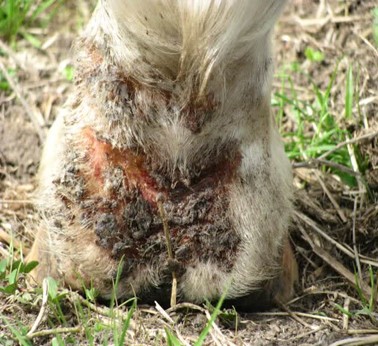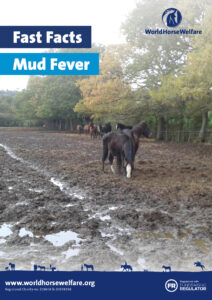What is mud fever?
The term can be used to refer to a wide range of skin conditions, properly known as pastern dermatitis. It can be caused by a variety of bacteria, which thrive in muddy, wet conditions.

What are the signs of mud fever?
If a horse does get mud fever, the signs you may see are quite distinctive and include:
- Matted areas of skin containing crusty scabs, with lesions beneath.
- There is often a thick discharge between the skin and the overlying scab.
- Heat and swelling, with the horse reacting to pressure or flexion of the affected limb
- Eventually, hair loss can leave inflamed, raw-looking skin which may split open at the back of the leg in severe cases, creating cracked heels.
If in doubt, call your vet to confirm it is mud fever before starting any treatment.
How do you treat mud fever?
- You’ll need to wash the affected leg(s) with a warm, very dilute Hibiscrub solution – 0.1% solution is recommended. Lather and leave on for 10 minutes then and rinse it off fully with warm, clean water.
- In severe cases the hair needs to be clipped away to allow thorough cleaning. This can be very painful and may need to be performed under sedation with your vet.
- Make sure you do use warm water to wash the affected areas (never cold) and never put neat Hibiscrub directly on to your horse’s skin.
- You need to dry the area thoroughly. This can be challenging in horses with thick feathers so you may have to consider clipping them out to tackle the mud fever successfully.
- Once your horse’s legs are clean and dry, apply a thin layer of absorbable antibacterial cream (speak to your vet about appropriate treatments). These bacterial like airless environments so avoid thick oily ointments.
- If the scabs have not come away with gentle cleaning and you stable your horse at night, you can cover the layer of barrier cream in cling film (ensuring it is not too tight). Then apply a stable bandage over the top and ensure your horse has clean, dry bedding. Leave the cream, cling film and bandages in place overnight to help loosen the scabs. In the morning you can then gently pick the scabs away, removing as much as possible. Be careful when doing this as the area can be very sore and it’s quite possible that your horse won’t like it. Never turn your horse out with bandages on as they can very easily cause rubs or injuries.
- Keep repeating this process until you’ve managed to remove all the scabs. At that stage, you can then leave the area clean, dry and exposed to the air overnight. It’s best to continue using a barrier cream during turnout until the area has healed completely.
- Thick barrier creams can be helpful as a preventative before turning your horse out for the day. This should only be applied to clean dry skin and not when lesions are present.
- In some very severe cases antibiotics or special dressings are required – please speak to your vet if you are concerned or feel your horses mud fever is not improving.
If your horse lives out, you won’t be able to use cling film and bandages to soften the scabs. If that’s the case, you’ll still need to regularly wash and dry the area thoroughly. You should then gently remove any scabs you can and apply a fresh layer of cream each time. There are now a variety of mud fever boots and ‘socks’ on the market which can be used in the field which may offer some protection. Try and minimise poaching of your paddocks, as the bacteria are transmitted in soil. Where possible provide areas of hard standing around gateways, shelters and water troughs to help prevent poaching.
Prevention is better than cure and it’s important to keep you horse’s legs as dry as possible, whether they are prone to mud fever or not. Treating mud fever as soon as you spot it, increases the success of treatment. It’s important to remain vigilant and check your horse’s legs daily.
Fast Facts guide to Mud fever

This Fast Facts guide includes:
- Clinical signs of mud fever
- Treatment of mud fever
- Risk factors and prevention strategies
Popular advice in Health

Mites: how to treat them in horses
Find out how our experienced teams tackle this itchy problem in affected horses and ponies.

Sweet itch
Sweet itch is one of the most common allergic skin diseases affecting horses in the UK - learn how to prevent and manage it.
Other advice categories
All webinar categories:
Call our Advice Line
+44 (0)1953 497 238Not found the advice or answer you were looking for here? Then our Advice Line is available during office hours, or you can email us on education@worldhorsewelfare.org to let us know what topics you were looking for.


